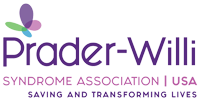Not on social media? No problem! PWSA (USA)’s daily PWS Awareness Month posts are available right here for you to access anytime.
Day 1
May is Prader-Willi Syndrome Awareness Month! Republican Congressman Ed Royce and Democratic Congresswoman Jane Harman co-sponsored the original House Resolution thanks to efforts by Amy Porter (Aunt to Colorado’s young Abby Porter who has PWS) and Prader Willi California Foundation members Tom and Renay Compere (parents to California’s William Compere) who brought this important cause to their attention. The House Resolution passed in December 2009, which then led to the Senate bill being passed on May 27, 2010, thereby establishing National Prader-Willi Syndrome Awareness Month!
Day 2
Prader-Willi syndrome is classified as a rare genetic disorder. The incidence rate of PWS is generally thought to be between 1 in 12,000 to 15,000 which means somewhere between 21,000 – 26,000 Americans have PWS. Because PWS is a rare disease, awareness and advocacy are essential to ensuring the needs of the PWS community are understood by all.
Day 3
Based on the incidence rate, there are somewhere between 21,000 and 26,000 Americans who have PWS. However, only about 8,000 are known to PWS organizations across the US. This means most cases are either undiagnosed or that the families have not connected with PWSA (USA).
PWSA (USA) works to increase awareness so that all individuals with Prader-Willi Syndrome can be diagnosed AND receive the support they need. One day ALL individuals with PWS will be properly diagnosed at birth because EVERYONE will know about Prader-Willi syndrome.
Day 4
Prader-Willi syndrome (pronounced PRAH-der WILL-ee) is caused by a genetic defect on the 15th chromosome. PWS was first identified in 1956 by Swiss doctors A. Prader, H. Willi and A. Labhart. There is no known cause for PWS nor is there a cure.
PWS is one of the ten most common conditions seen in genetics clinics, and is the most common genetic cause of childhood obesity.
Day 5
PWS is a randomly occurring genetic abnormality that takes place at conception. It affects both males and females and occurs across all races.
The two most common types of PWS are Deletion and Uniparental Disomy (UPD). Deletion accounts for approximately 70% of cases and happens when an individual has a non-inherited deletion in the 15q11-q13 region of the paternal 15th chromosome. Uniparental Disomy (UPD) accounts for approximately 25% of cases and happens when an individual receives two maternal 15th chromosomes and no paternal 15th chromosome. In rare cases there can be an imprinting error where the father’s chromosome is present but does not work properly ( this type is very rare and therefore PWS is considered to be non-inherited).
Day 6
PWS causes the hypothalamus (considered the command center of the brain) to function improperly. This malfunction impacts a number of things, including metabolism, temperature regulation, various hormones, muscle tone, emotional reactions, stress response, and of course, the hallmark trait of PWS, appetite regulation.
PWS is a spectrum disorder, meaning that PWS is not a one-size-fits-all diagnosis and every person with PWS has his or her own unique abilities and challenges.
Day 7
Hyperphagia, or excessive appetite, is a hallmark trait of Prader-Willi syndrome. Though the exact cause isn’t fully understood, individuals with PWS lack the normal signals of feeling full and therefore ALWAYS feel hungry. Hyperphagia is often the symptom most often associated with PWS, however, it is one of many.
Another symptom of PWS is very low metabolism (up to 50% of what is considered “normal’). When combined with hyperphagia, very low metabolism is a recipe for obesity and all the health problems associated with it.
Through diligence in food control, an individual with PWS can be thin. However, individuals with PWS who are overweight are not so due to parental or caregiver negligence. He or she might have an extremely low metabolism (even for PWS) or might be on the extreme end of the hyperphagia continuum. They might have received a late diagnosis and are just now trying to take off the weight, they might not be aware of the best nutrition recommendations for PWS, or they might not have access to a physician familiar with they syndrome. No matter what, weight management in PWS is a life-long, extremely challenging issue.
Day 8
Hyperphagia is a hallmark symptom of Prader-Willi syndrome. However, individuals with PWS don’t start out with an excessive food drive. In fact, most are diagnosed with “failure to thrive” in infancy because they have hypotonia (low muscle tone) and are too weak to eat.
One of the mysteries of PWS is in trying to figure out exactly what causes the “switch” to hyperphagia. In the past, the age of onset was considered to be around the age of two, and while that is still true for some, many are now finding the onset of hyperphagia to come much later.
Day 9
Individuals with Prader-Willi syndrome are often diagnosed with “failure to thrive” as infants. This is due to global hypotonia, or decreased or low muscle tone, negatively impacts the many muscles of the mouth making it difficult for infants with PWS to suckle to eat. As such, many infants require assistance with feeding by way of NG tubes (feeding through the nose) or g-tubes (directly into the stomach) until they are strong enough to eat on their own.
Hypotonia continues to impact individuals with PWS throughout their lives. Developmental milestones and speech are often delayed. Articulation can remain an issue long after speech is developed, and anything involving gross or fine motor skills (writing, swimming, riding a bike, etc.) takes much longer to develop or master. Exercise can improve muscle tone to some extent, however, individuals with PWS will oftentimes remain weaker than their peers, struggling with endurance throughout life.
Day 10
Individuals with Prader-Willi syndrome have a much slower metabolism than the average person…up to 90 times slower!
Imagine always feeling hungry but needing only half the calories your friends do to survive. For individuals with PWS, it can be far too easy to gain weight yet difficult to get proper nutrition on calorie-restricted diets. This is why there is NO room for empty calories. Every calorie counts and any special “treats” must be accounted for in the daily calorie intake or with extra exercise.
Day 11
With help, people with PWS can, and do, accomplish many of the things their “normal” peers do. With proper support, they can finish school, excel in their areas of interest, obtain successful employment, and even move away from their family home. However, they can’t do these things without significant support from their families and from school, work, and residential service providers. Even individuals with IQs in the normal range need lifelong diet supervision and protection from food availability.
In the past, many people with PWS died in adolescence or young adulthood. However, prevention of obesity (and the many health risks associated with it) can enable those with the syndrome to live a normal lifespan. New medications, including psychotropic drugs and synthetic growth hormone, are already improving the quality of life for some people with PWS. Ongoing research offers the hope of new discoveries that will enable people affected by this unusual condition to live more independent lives.





 Jennifer Bolander has been serving as a Special Education Specialist for PWSA (USA) since October of 2015. She is a graduate of John Carroll University and lives in Ohio with her husband Brad and daughters Kate (17), and Sophia (13) who was born with PWS.
Jennifer Bolander has been serving as a Special Education Specialist for PWSA (USA) since October of 2015. She is a graduate of John Carroll University and lives in Ohio with her husband Brad and daughters Kate (17), and Sophia (13) who was born with PWS. Perry A. Zirkel has written more than 1,500 publications on various aspects of school law, with an emphasis on legal issues in special education. He writes a regular column for NAESP’s Principal magazine and NASP’s Communiqué newsletter, and he did so previously for Phi Delta Kappan and Teaching Exceptional Children.
Perry A. Zirkel has written more than 1,500 publications on various aspects of school law, with an emphasis on legal issues in special education. He writes a regular column for NAESP’s Principal magazine and NASP’s Communiqué newsletter, and he did so previously for Phi Delta Kappan and Teaching Exceptional Children. Evan has worked with the Prader-Willi Syndrome Association (USA) since 2007 primarily as a Crisis Intervention and Family Support Counselor. Evans works with parents and schools to foster strong collaborative relationships and appropriate educational environments for students with PWS.
Evan has worked with the Prader-Willi Syndrome Association (USA) since 2007 primarily as a Crisis Intervention and Family Support Counselor. Evans works with parents and schools to foster strong collaborative relationships and appropriate educational environments for students with PWS. Dr. Amy McTighe is the PWS Program Manager and Inpatient Teacher at the Center for Prader-Willi Syndrome at the Children’s Institute of Pittsburgh. She graduated from Duquesne University receiving her Bachelor’s and Master’s degree in Education with a focus on elementary education, special education, and language arts.
Dr. Amy McTighe is the PWS Program Manager and Inpatient Teacher at the Center for Prader-Willi Syndrome at the Children’s Institute of Pittsburgh. She graduated from Duquesne University receiving her Bachelor’s and Master’s degree in Education with a focus on elementary education, special education, and language arts. Staci Zimmerman works for Prader-Willi Syndrome Association of Colorado as an Individualized Education Program (IEP) consultant. Staci collaborates with the PWS multi-disciplinary clinic at the Children’s Hospital in Denver supporting families and school districts around the United States with their child’s Individual Educational Plan.
Staci Zimmerman works for Prader-Willi Syndrome Association of Colorado as an Individualized Education Program (IEP) consultant. Staci collaborates with the PWS multi-disciplinary clinic at the Children’s Hospital in Denver supporting families and school districts around the United States with their child’s Individual Educational Plan. Founded in 2001, SDLC is a non-profit legal services organization dedicated to protecting and advancing the legal rights of people with disabilities throughout the South. It partners with the Southern Poverty Law Center, Protection and Advocacy (P&A) programs, Legal Services Corporations (LSC) and disability organizations on major, systemic disability rights issues involving the Individuals with Disabilities Education Act (IDEA), Americans with Disabilities Act (ADA), and the federal Medicaid Act. Recently in November 2014, Jim retired.
Founded in 2001, SDLC is a non-profit legal services organization dedicated to protecting and advancing the legal rights of people with disabilities throughout the South. It partners with the Southern Poverty Law Center, Protection and Advocacy (P&A) programs, Legal Services Corporations (LSC) and disability organizations on major, systemic disability rights issues involving the Individuals with Disabilities Education Act (IDEA), Americans with Disabilities Act (ADA), and the federal Medicaid Act. Recently in November 2014, Jim retired.